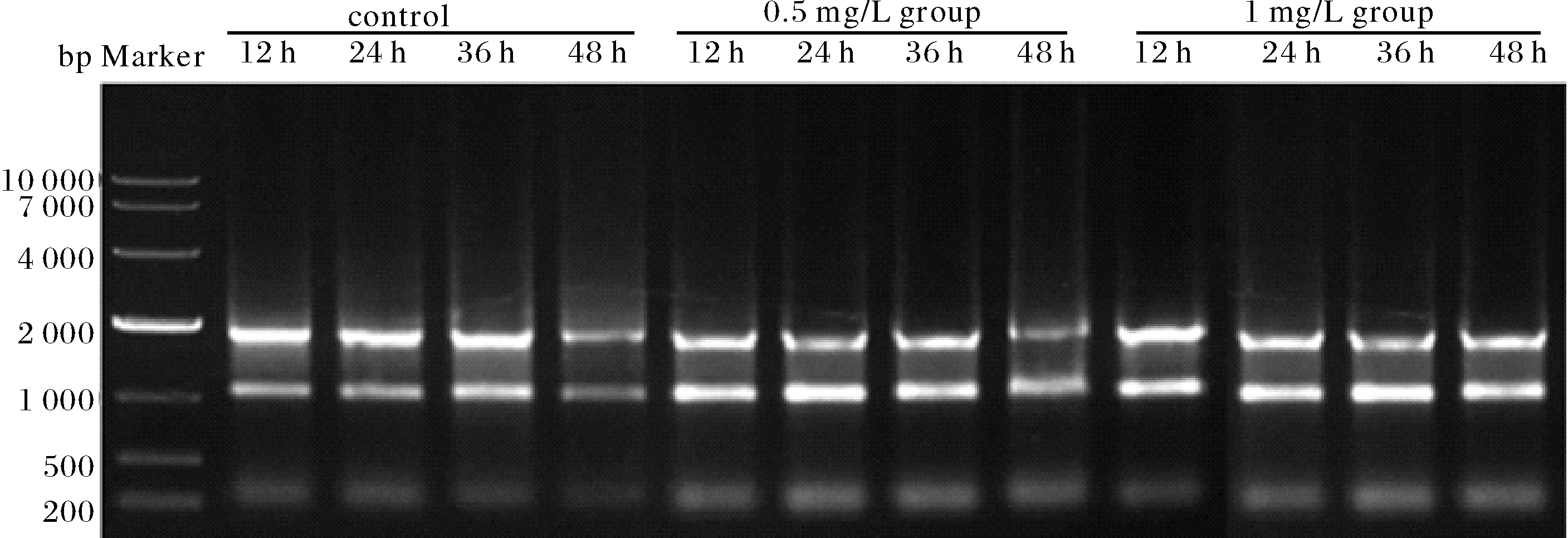Mechanism exploration of xylitol selenite-inducedapoptosis in a human hepatoma cell lineSMMC-7221 cells using real-time quantitative PCR
SHEN Hao, CAO Yu, LEI Ming, ZAHID Kashif Rafiq , WU Xue,LIU Ke, LIU Yanli, LIU Jinlin, YANG Jihong, ZHAO Haobin, QI Chao*
( 1.Hubei Key Laboratory of Genetic Regulation and Integrative Biology, College of Life Science,Central China Normal University, Wuhan 430079;2.College of Chemistry, Central China Normal University, Wuhan 430079)
Mechanism exploration of xylitol selenite-inducedapoptosis in a human hepatoma cell lineSMMC-7221 cells using real-time quantitative PCR
SHEN Hao1#, CAO Yu2#, LEI Ming1, ZAHID Kashif Rafiq1, WU Xue1,LIU Ke1, LIU Yanli1, LIU Jinlin1, YANG Jihong1, ZHAO Haobin1, QI Chao1*
( 1.Hubei Key Laboratory of Genetic Regulation and Integrative Biology, College of Life Science,Central China Normal University, Wuhan 430079;2.College of Chemistry, Central China Normal University, Wuhan 430079)
Xylitol selenite, a novel synthetic compound, which is able to cause apoptosis in human hepatoma cell line SMMC-7221 cells and induce apoptosis following GSH depletion. To provide more investigation on its anti-cancer mechanisms, the changes of caspase-3, caspase-8 and caspase-9 in mRNA levels in SMMC-7221 cells treated with xylitol selenite were determined using real-time quantitative PCR. After treated with 0.5 or 1 mg/L xylitol selenite for 12, 24, 36, and 48 h, significant upregulation in the mRNA expression of caspase-3 was observed, comparing with control group. Moreover, expressions of both caspase-8 and caspase-9 mRNA only markedly varied in 24 h, and there were no significant differences at other time points. In contrast to control group, expressions of caspase-3, caspase-8 and caspase-9 mRNA were upregulated at 12 h, reaching its peak at 24 h and beginning to decrease at 36 and 48 h after xylitol selenite treatment.Xylitol selenite, a promising anti-cancer drug to induce apoptosis in SMMC-7221 cells, may regulate the apoptosis through extrinsic and intrinsic pathway and more studies on its anti-cancer mechanisms should be determined.
apoptosis; anti-cancer; caspase pathway; real-time quantitative PCR; xylitol selenite
Selenium, an essential micronutrient required for human and animal, is capable of inhibiting carcinogenesis in several cells and animal models. Xylitol selenite is a new synthetic compound, which leaded to death of SMMC-7221 (a human hepatoma cell line) by causing apoptosis but not necrosis[1], and induced apoptosis following GSH depletion[2].
Caspases, a family of cysteine proteases, mainly function as the central regulation of cell apoptosis[3]. Based on inflammation and other different functions, mammalian caspase-3,-8,-9 are apoptotic caspases[4]. Meanwhile, some studies have reported that several selenocompounds induce apoptosis through mechanisms of caspase regulation[5-7]. In caspase-mediated apoptosis signaling pathways, caspase activation can be regulated through an extrinsic or intrinsic signaling pathway[3]. Caspase-8 and caspase-9 play crucial role in extrinsic and intrinsic pathway respectively, and mediate activation of caspase-3[4]. Therefore, the changes of caspase-3,-8,-9 in mRNA levels were examined to explore the mechanism of xylitol selenite-induced apoptosis.
1Material and methods
TRI Reagent®was purchased from Sigma-Aldrich (St. Louis, USA). Random primer, M-MLV Reverse Transcriptase, dNTP, M-MLV 5×Reaction buffer, and RNasin®Ribonuclease were purchased from Promega (Madison, USA). SYBR®Premix Ex TaqTMⅡwas purchased from Takara (Kusatsu, Japan). Xylitol selenite (contain 38% Se) was obtained from the College of Chemistry (Central China Normal University, Wuhan, China). Dulbecco’s Modified Eagle Medium (DMEM) was purchased from Hyclone (Logan, USA), fetal bovine serum (FBS) and penicillin-streptomycin was purchased from Thermo Fisher (MA, USA). Human hepatoma cell line SMMC-7221 was purchased from the China Center for Type Culture Collection (Wuhan, China).
1.1Cell culture and treatment procedure
SMMC-7221 cells were cultured in DMEM with 10% FBS and penicillin-streptomycin, then maintained in a humidified 5% CO2atmosphere at 37°C. SMMC-7221 cells were seeded in the 6-well plate with 5×105cells/mL, cultured about 15 h to grow until 80% confluence. Confluent cells were treated with serum-free medium in the absence or presence of 0.5 or 1 mg/L xylitol selenite for 12, 24, 36, 48 h.
1.2RNA isolation and the quality of RNA detection
Total RNA was isolated by TRI Reagent®following the manufacturer’ instruction. Then, the concentration of total RNA was measured by UV spectrophotometer. And RNA integrity was detected by electrophoresis in 1% (w/v) agarose gel.
1.3Reverse transcription
To synthesize cDNA, 1 μL random primer (10 μM), 12 μL DEPC water, and 1 μg total RNA were denatured at 70℃ for 10 min and immediately put on ice for 5 min. The following reagents were added: 5 μL of 5×M-MLV reverse transcriptase buffer, 1 μL of dNTP, 1 μL of Rnasin®Ribonuclease, 1 μL M-MLV reverse transcriptase. The contents were mixed gently and incubated for 60 min at 37℃, then incubated for 5 min at 70℃, finally held at 4℃. All cDNA samples were stored at -80℃ until use.
1.4Real-time quantitative PCR
Primers were designed for PCR amplification of cDNA and each cytokine quantification by real-time quantitative PCR. And the sequences of the primers are shown as Tab.1. Real-time quantitative PCR assays were performed in duplicate using a CFX96 Sequence Detection System (Bio-Rad, USA). PCR amplifications were performed in reaction mixtures consisting of 2 μL cDNA template, 1 μL 10 μM each of forward and reverse primers, 8.5 μL DEPC water, 12.5 μL SYBR®Premix Ex TaqTMⅡ. Real-time quantitative PCR reactions involved an initial denaturation step at 95℃ for 30 s followed by 40 cycles of amplification (denaturation at 95℃ for 15 s, and annealing/extension at 60℃ for 60 s). After the amplification phase, a melting curve analysis was performed to eliminate the possibility of non-specific amplification or primer-dimer formation. Each reaction was performed in triplicate and the mRNA levels of caspase-3, caspase-8 and caspase-9 were normalized by a housekeeping gene β-actin. The relative quantification of the mRNA in each sample was calculated using the 2-△△Ctmethod[8].
1.5Statistical analysis
Each value was expressed as means ± SD obtained from at least three independent experiments and statistically analyzed by SPSS Statistics software. The differences between the control group and each treatment group were analysis by Student’s t test. The level of significance was based on the calculatedpvalue.
2Results
2.1RNA integrity identification
RNA integrity of all samples were suitable for real-time quantitative PCR as indicated in Fig.1.

Tab.1 Real-time PCR Primers

Fig.1 RNA formaldehyde modified gel electrophoresis with different concentrations of xylitol selenite in SMMC-7221 cells.
2.2Effects of each cytokine quantification by real-time quantitative PCR
As shown in Fig. 2, after treated with 0.5 or 1 mg/L xylitol selenite for 12, 24, 36, 48 h in SMMC-7221 cells, compared with control group, there was a significant upregulation in the mRNA expression of caspase-3 from 12 h to 48 h. Besides that, caspase-8 mRNA only markedly varied at 24 h treated with xylitol selenite, and at other times, a modest increase was shown. In addition, the changes of caspase-9 mRNA were similar to caspase-8. In contrast to control group, mRNA levels of caspase-3, caspase-8 and caspase-9 began to rise at 12 h, got maximum differentiation at 24 h, and gradually decline at 36 h and 48 h. In the meantime, mRNA expression levels of caspase-3, caspase-8 and caspase-9 were shown higher than control group from 12 h to 48 h. Besides, 1 mg/L treatment group exhibited a similar variation tendency compared to 0.5 mg/L treatment group.

Fig.2 Relative mRNA expression (fold change to β-actin) of caspase-3, caspase-8 and caspase-9 with different concentrations of xylitol selenite from 12 h to 48 h. **p< 0.01; *p< 0.05; NS=not significant (n=3).
3Discussion
In the previous study, Lei et al. found xylitol selenite caused death of SMMC-7221 cells by causing apoptosis and not necrosis, and half-maximal inhibition was obtained in the presence of 0.5 mg/L xylitol selenite . Moreover, Wu et al. discovered 0.5 mg/L and 1 mg/L xylitol selenite both induced cell apoptosis with GSH depletion. Therefore, 0.5 and 1.0 mg/L xylitol selenite were used for apoptosis assay to identify its effect.
Caspase family members including caspase-3, caspase-8 and caspase-9 play considerable roles in cell apoptosis, by which the mechanism of xylitol selenite induced apoptosis can be determined. Some studies have reported that several selenocompounds induce apoptosis through caspase-independent pathway. Here, variety of caspase-3, caspase-8 and caspase-9 in mRNA levels were tested. Compared with the control group, caspase-3 mRNA was obviously increased from 12 h to 48 h. In addition, caspase-8 was increased remarkably at 24 h and it was shown a slight increase at other times. Furthermore, mRNA level of caspase-9 was shown a slight increase all the time. Herein, it was shown that caspase-3, caspase-8 and caspase-9 were increased in mRNA levels. However, how the changes of caspase-3, caspase-8 and caspase-9 in protein levels was unknown. In general, it was speculated that caspase-3, caspase-8 and caspase-9 were activated in xylitol selenite induced apoptosis.
Several reports have revealed that the extrinsic pathway which involves Fas and tumor necrosis factor receptors (TNFRs) stimulation and activates caspase-8. Besides, the intrinsic pathway may be the primary means of activating apoptotic caspase, triggers the mitochondrial release of cytochrome c (cyt-c), which oligomerizes with Apaf-1 and procaspase-9 to form the apoptosome complex. In this complex, activated caspase-9 promotes caspase-3 to execute apoptosis[9-11]. Combining with the data[2], it indicates that the mechanism of xylitol selenite induced apoptosis in SMMC-7221 cells involves extrinsic and intrinsic pathway and with GSH depletion. For more extensive application of xylitol selenite and other Se compounds in future, more research on mechanism is conducted besides determining variety of caspase-3, caspase-8 and caspase-9.
[1] LEI M, CHEN D D, DENG X J, et al. Dynamic sieving capillary electrophoresis analysis of xylitol selenite-induced apoptosis in SMMC-7221 cells [J]. Biotechnol Lett, 2012, 34(9): 1617-1621.
[2] WU X, CAO Y, ZHANG J, et al. Determination of glutathione in apoptotic SMMC-7221 cells induced by xylitol selenite using capillary electrophoresis [J]. Biotechnol Lett, 2016, 38(5):761-766.
[3] SANMARTIN C, PLANO D, SHARMA A K, et al. Selenium compounds, apoptosis and other types of cell death: an overview for cancer therapy[J]. Int J Mol Sci, 2012, 13(8):964 9-9672.
[4] SHALINI S, DORSTYN L, DAWAR S, et al. Old, new and emerging functions of caspases [J]. Cell Death and Differ, 2015, 22(4):526-539.
[5] DAS R K, HOSSAIN S K U, BHATTACHARYA S. Diphenylmethyl selenocyanate inhibits DM BA-croton oil induced two-stage mouse skin carcinogenesis by inducing apoptosis and inhibiting cutaneous cell proliferation [J]. Cancer Lett, 2005, 230(1):90-101.
[6] KIM T, JUNG U, CHO D Y, et al. Se-methylselenocysteine induces apoptosis through caspase activation in HL-60 cells [J]. Carcinogenesis, 2001, 22(4):559-565.
[7] GUO P, WANG Q, LIU J, et al. Preparation of two organoselenium compounds and their induction of apoptosis to SMMC-7221 cells [J]. Biol Trac Elem Res, 2013, 154(2):304-311.
[8] LIVAK K J, SCHMITTGEN T D. Analysis of relative gene expression data using real-time quantitative PCR and the 2 (-Delta Delta C(T)) Methods [J]. Methods, 2001, 25(4):402-408.
[9] MACKENZIE S H, SCHIPPER J L, CLARK A C. The potential for caspases in drug discovery[J]. Curr Opin Drug Discov Devel, 2010, 13(5):568-576.
[10] WLODKOWIC D, TELFORD W, SKOMMER J, et al. Apoptosis and beyond: cytometry in studies of programmed cell death [J]. Methods Cell Biol, 2011, 103(103):55-98.
[11] PARK H H. Structural features of caspase-activating complexes [J]. Int J Mol Sci, 2012, 13(4):4807-4818.
2016-11-04.
国家自然科学基金项目(31300629,31272645,31672284);中央高校基本科研业务费项目(CCNU14F01006);遗传调控与整合生物学湖北省重点实验室项目(GRIB201505).
1000-1190(2017)01-0079-05
荧光定量PCR测定木糖醇亚硒酸酯诱导人肝癌细胞系SMMC-7221细胞凋亡的机制研究
沈 浩1, 曹 郁2, 雷 明1, ZAHID Kashif Rafiq1, 吴 雪1,刘 珂1, 刘艳丽1, 刘金林1, 杨继红1, 赵浩斌1, 祁 超1
(1.华中师范大学 生命科学学院 遗传调控与整合生物学湖北省重点实验室, 武汉 430079;2.华中师范大学 化学学院, 武汉 430079)
木糖醇亚硒酸酯是一种新合成的化合物,其能够引发人肝癌细胞系SMMC-7221细胞凋亡并且其引发SMMC-7221细胞凋亡伴随着谷胱甘肽的消耗.为了提供更多关于木糖醇亚硒酸酯的抗癌机制研究,该实验用荧光定量PCR技术检测经该化合物处理后的SMMC-7221细胞中caspase-3、caspase-8、caspase-9这3个基因mRNA水平的变化.在经0.5 mg/L 或1 mg/L木糖醇亚硒酸酯分别处理SMMC-7221细胞12、24、36、48 h后,与对照组相比,caspase-3的mRNA表达水平从12~48 h内显著上调;此外,caspase-8和caspase-9的mRNA表达水平仅在24 h显著变化,而在其他时间点与对照组相比变化不明显.与对照组相比,caspase-3、caspase-8、caspase-9的mRNA表达在12 h上升,在24 h到达最大值,在36 h和48 h逐渐下降.木糖醇亚硒酸酯作为一个能够诱导细胞凋亡的有应用前景的抗癌药物,可能是通过内源性和外源性信号通路引发SMMC-7221细胞凋亡,其深层次的抗癌机制需要更进一步的研究.
凋亡; 抗癌; caspase途径; 荧光定量PCR; 木糖醇亚硒酸酯
Q291
A
# 前两位作者对本文具有相同贡献,为共同第一作者.
*通讯联系人. E-mail: qichao@mail.ccnu.edu.cn.

